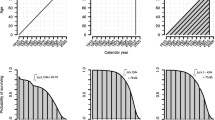Abstract
We use an advanced methodology based on the mortality rate of a population to explore the healthy life expectancy (HALE) estimates of the World Health Organization (WHO) from the Global Burden of Disease Study. First we calculate the loss of healthy life year estimator (LHLY) and then the healthy life expectancy (HLE). We use the full life tables from the Human Mortality Database (HMD). Our estimates are compared with the HALE estimates for Italy and other countries. Another direct estimation based on the mx and qx quantities provided from the Life Tables is also introduced and tested.
Analysis of the health situation in Italy males and females is presented along with the healthy life expectancy estimates.
Access this chapter
Tax calculation will be finalised at checkout
Purchases are for personal use only
Similar content being viewed by others
References
Brouard, N. (1980). Espérance de vie active, reprises d’activité féminine: un modèle. Revue économique, 31, 1260–1287.
Cambois, E., Robine, J. M., & Brouard, N. (1999). Life expectancies applied to specific statuses. A history of the indicators and methods of calculation. Population: An English Selection, 11, 7–34.
Giudici, C., Arezzo, M. F., & Brouard, N. (2013). Estimating health expectancy in presence of missing data: An application using HID survey. Statistical Methods and Applications, 22, 517.
Hoem, J., & Fong, M. (1976). A Markov chain model of working life tables (Working paper 2 Laboratory of Actuarial Mathematics). Copenhagen: University of Copenhagen.
McDowell, I. (2006). Measuring health: A guide to rating scales and questionnaires (3rd ed.). Oxford/New York: Oxford University Press.
Murray, C. J. L., et al. (2016). Global, regional, and national disability-adjusted life-years (DALYs) for 315 diseases and injuries and healthy life expectancy (HALE), 1990–2015: A systematic analysis for the global burden of disease study 2015. Lancet, 388, 1603–1658.
Rogers, A. (1975). Introduction to multi regional mathematical demography. New York: Wiley.
Salomon, et al. (2012). Healthy life expectancy for 187 countries, 1990–2010: A systematic analysis for the global burden disease study 2010. Lancet, 380, 2144–2162.
Skiadas, C. H. (2015, October). Verifying the global burden of disease study: Quantitative methods proposed. Ar**v.org. http://arxiv.org/abs/1510.07346
Skiadas, C. H. (2016). Exploring the HALE estimates of the global burden of disease study by a simple, Gompertz, Weibull and an advanced IM model. 28th REVES conference, Wien, Austria, 8–10 June 2016.
Skiadas, C., & Skiadas, C. H. (2010). Development, simulation and application of first exit time densities to life table data. Communications in Statistics – Theory and Methods, 39(3), 444–451.
Skiadas, C. H., & Skiadas, C. (2014). The first exit time theory applied to life table data: The health state function of a population and other characteristics. Communications in Statistics-Theory and Methods, 34, 1585–1600.
Skiadas, C. H., & Skiadas, C. (2015). Exploring the state of a stochastic system via stochastic simulations: An interesting inversion problem and the health state function. Methodology and Computing in Applied Probability, 17, 973–982.
Skiadas, C. H., & Skiadas, C. (2017). Exploring the health state of a population by dynamic modeling methods. The Springer Series on Demographic Methods and Population Analysis book series (PSDE, Vol. 45), Springer. https://doi.org/10.1007/978-3-319-65142-2., https://springer.longhoe.net/book/10.1007/978-3-319-65142-2
Sullivan, D. (1971). A single index of mortality and morbidity. HSMHA Health Reports, 86(4), 347–354.
WHO. (2014). WHO methods for life expectancy and healthy life expectancy. Global Health estimates technical paper WHO/HIS/HSI/GHE/2014.5. March, 2014. http://www.who.int/healthinfo/statistics/LT_method.pdf
WHO. Department of Health Statistics and Information system. (2013). WHO methods and data sources for the global burden of disease estimates 2000–2011. Global health estimates technical paper WHO/HIS/HSI/GHE/2013.4. November, 2013.http://www.who.int/healthinfo/statistics/GlobalDALYmethods_2000_2011.pdf
WHO. The World 132 Health Report. (2004). Statistical annex, annex table 4 healthy life expectancy (HALE) in all WHO member states, estimates for 2002. annex_4_en_2002.pdf
WHO. The World Health Report. (2001). Statistical annex, annex table 4 healthy life expectancy (HALE) in all member states, estimates for 2000. annex4_en_HALE_2000.pdf
WHO. The World Health Report. (2002). Statistical annex, annex table 4 healthy life expectancy (HALE) in all member states, estimates for 2000 and 2001. whr2002_annex4_2001.pdf
Willekens, F. (1979). Computer program for increment-decrement (multistate) life table analysis: A user’s manual to lifeindec. Working papers of the international institute for applied systems analysis.
Wolfbein, S. (1949). The length of working life. Population Studies, 3, 286–294.
Author information
Authors and Affiliations
Corresponding authors
Editor information
Editors and Affiliations
Rights and permissions
Copyright information
© 2018 Springer International Publishing AG, part of Springer Nature
About this chapter
Cite this chapter
Skiadas, C.H., Arezzo, M.F. (2018). Estimation of the Healthy Life Expectancy in Italy Through a Simple Model Based on Mortality Rate. In: Skiadas, C., Skiadas, C. (eds) Demography and Health Issues. The Springer Series on Demographic Methods and Population Analysis, vol 46. Springer, Cham. https://doi.org/10.1007/978-3-319-76002-5_4
Download citation
DOI: https://doi.org/10.1007/978-3-319-76002-5_4
Published:
Publisher Name: Springer, Cham
Print ISBN: 978-3-319-76001-8
Online ISBN: 978-3-319-76002-5
eBook Packages: Social SciencesSocial Sciences (R0)



